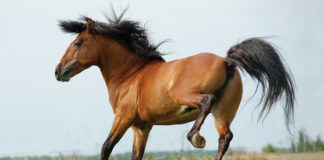After moving from Kentucky to coastal Southern California, my horse Artie had a rude shock to the system: He went from 24/7 pasture board to full-time life in a 12×24-foot pipe corral. Although the weather is always nice and he has plenty of friends around him, I can’t help but feel bad that he doesn’t get to graze anymore. Where we live, land is too expensive to turn out a horse anywhere besides the arena for a few minutes during quiet times of the day. At a busy boarding barn with hundreds of horses on 6 or 7 acres, that isn’t too often! After studying equine nutrition in depth for my master’s degree, I learned some important tips and tricks to care for and keep a horse well-fed (and perhaps more importantly, sane) if he must live the unnatural full-time stall life.

Re-Create Grazing
The best way to care for and create a nutrition plan for a horse who lives in a stall is by recreating this scenario as closely as possible. Slow feeders or a hay net with small holes are your new best friend. Any feeder with large holes (or one large hole, like a trough) will be too easily emptied in minutes.
Assuming horses at your barn are fed at least twice daily, you will need to have someone pack your net or feeder once or twice per day for your horse to work on. If your horse lives close by or on your own property, this makes things a lot easier, but you can usually find enterprising teens or contractors/working students willing to do it for a small fee.
If your horse tends to put on weight very easily, feed a grass hay (as opposed to alfalfa), and preferably one that was cut at a slightly more mature stage. Early cut hay has a high leaf-to-stem ratio, which is more packed with calories.
Now for the payoff of this care and nutrition plan: Your stalled horse will reap the rewards of a busy digestive system that is less prone to impaction by having a constant stream of fiber moving through his gut. Another benefit of a stomach filled with hay is that it is more resilient against the acid that creates gastric ulcers. Yes, hay is expensive, but vet visits and ulcer meds are even more so!
Alfalfa hay is thought to have a further acid-buffering property due to its high calcium content (think Tums for horses), but this is best for horses in heavier work or those who are hard keepers, due to its higher calorie count per pound. An obese horse has a plethora of other health risks that are best avoided by choosing an alternative to alfalfa.
Finally, be sure to have clean water and a salt block available at all times. Water is critical in helping prevent intestinal impactions, so make sure the buckets or auto-waterer are cleaned daily and located in full shade. Most horses are excellent at self-regulating their salt intake when a salt block is available.
Get Your Horse Out of the Stall Often
For a horse stuck in a stall all day, we can’t ignore his natural desire to move around. Though he can “graze” on a hay net, natural grazing involves miles of walking every day as well.
Unless your horse is on strict injury rehab, get him out of the stall for at least an hour a day. Even if you don’t ride, just hand-walking him is beneficial. Horses rely on movement to circulate lymph through their system and prevent stocking up, so walk him often or use a gentle session on the longe line for some trotting if you have less time.
Physical activity will have the added benefit of helping move your horse’s gut along. If you can get him out both morning and evening, that’s even better.
Social Circles
Mutual grooming and horsey friendships are an important part of herd dynamics in the field. If possible, find a housing situation where your horse can see and smell his neighbors; stalls with grills as opposed to solid walls are best. Horses love to hang their head out their stall door to see everyone in the aisle and watch what’s going on, so the more open, the better.
This also helps with ventilation, which is very important for equine respiratory health. Even in colder months, barn doors should be open to allow air to move through and prevent dust from hay and bedding and ammonia fumes from concentrating in the air.
If your horse dislikes a neighbor, try moving him around and switching stalls until he finds friendly companions. This further reduces stress and risk of ulcers or behavioral problems.
By trying to make his stall life as natural as possible with the right care and nutrition, you will help lower your horse’s stress level and take measures to fend off some common health problems.
This article about nutrition and care for a horse in a stall appeared in the July 2022 issue of Horse Illustrated magazine. Click here to subscribe!





